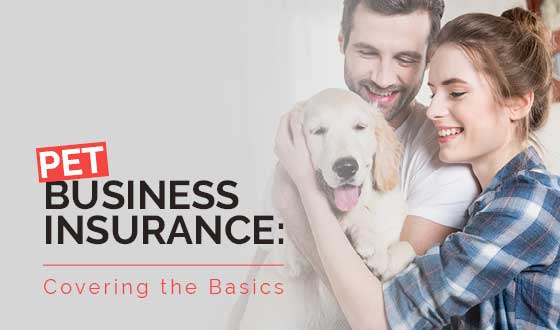There’s always a chance that the worst-case scenario comes true. Whether it’s simple mistakes when providing services, pet losses, or the resulting legal issues from either—pet business insurance is crucial to stay afloat when problems arise.
However, the world of pet business insurance can be difficult to navigate. Business insurance, in general, can be hard to understand. Then with pet-care insurance, there is often specialized coverage to factor in.
When creating your dog daycare business plan, choosing the right business insurance to cover your operations is a crucial step. We’ll explore the basics of pet business insurance through the following points:
- Pet Business Insurance: An Overview
- What types of dog daycare business insurance are available?
- Choosing Coverage: 4 Pet Business Insurance Considerations
Are you ready to explore dog daycare business insurance, as well as how you can mitigate your business’s risk overall? Let’s get started.
Pet Business Insurance: An Overview
Why invest in pet-care business insurance?
There are a variety of reasons why your organization may choose to invest in pet business insurance—the least of which being general business best practices.
It doesn’t matter if you hire the most experienced pet-care workers and carefully screen each furry guest under a microscope. It doesn’t matter if you exclusively welcome smaller animals, older animals, or any other subset characteristic that may make things feel “safer.”
In pet care, unpredictability is to be expected. After all, you’re dealing with guests that might struggle to vocalize their concerns—in any language other than barking, that is. Succeeding in the midst of this unpredictability is a practice of training, setting risk management procedures, and investing in strong insurance coverage for those moments when accidents happen.
Pet business insurance ensures that:
- Clients trust your business to keep their pets safe.
- Peripheral investors (think: your landlord, bank lender) trust you to protect their investment.
- Your staff is protected.
- Your current and future assets are protected.
When opening your pet-care business, the best thing you can do is prepare. Ideally, you’ll never have to make use of the insurance policies you invest in—but just in case, you’ll be happy you covered your bases.
How much does dog daycare insurance cost?
The cost of dog daycare insurance varies greatly, depending on a few different factors.
With some companies offering baseline coverage for as low as under $200 a year, the price can also rise into the thousands. Your best bet for discovering how much insurance will cost for your pet-care business is to request quotes from a variety of providers familiar with the field.
Some factors that might affect the cost of your pet business insurance plan are:
- The size of your business.
- The type of business you operate (daycare, kennel, groomer, etc.).
- The services you provide (training, overnight care, walks, home visits).
- The location that your business is located in.
- The level of coverage you believe is necessary.
For example, some insurance providers will set a low baseline rate but increase coverage pricing for businesses that provide grooming or training services. Because each provider handles this differently, it’s up to you to request quotes to discover not just how much pet business insurance costs, but how much it will cost for your business.
How do I choose pet business insurance?
Choosing a pet business isn’t a decision to take lightly. Not only will you regularly make payments to the insuring body, but the coverage you choose could potentially save your business if you have any future conflicts.
While there are a ton of insurance companies providing general business insurance, your company will have certain specific needs. Covering for pet injury, alleged mistreatment, runaway costs, or even veterinary treatment are all issues that other businesses usually don’t have to worry about. You want to choose an insurance provider that’s familiar with the pet-care field and works with other businesses just like yours.
You could choose a business that’s built on the pet-care field, such as PetCare Insurance, or you could choose a general business insurance provider that fulfills your needs.
It’s important to shop around, asking peers in your field for their recommendations. Further, turn to professional pet-care associations, such as the International Boarding & Pet Services Association (IBPSA), and search their directories for insurance providers that are members. You’ll want a provider that’s up-to-date on all the latest pet business news, and association membership is a great indicator.
Just as with any service, there’s something you need to figure out before you start shopping for an insurance provider: The types of insurance you need.
What types of dog daycare business insurance are available?
There are many different insurance policies that can reasonably be applied to pet-care businesses, both on the more general fronts and the more technical. Let’s explore a few of the most common insurance policies to begin your research.
Commercial Liability Insurance
Commercial liability insurance provides general coverage for your business as a whole. It’s directly related to the overall operations of your business, and any issues that might arise during or due to your operations.
Note this insurance does not cover issues specifically tied to your pet-care services (directly interacting with animals), which will be covered later.
For example, here are a few scenarios that might be covered by pet business commercial liability insurance:
- A client is injured on your premises, perhaps by tripping on spilled water.
- A client’s property is damaged when your staff is in their home.
- There’s a water pipe leak on your premises and it causes damage to nearby businesses.
This type of insurance covers your business in the event of a lawsuit and any resulting damages. It’s essential that coverage limits are high enough to cover potential scenarios.
Property Insurance
Property insurance is fairly straightforward, covering your physical assets in the event of an emergency that’s out of your control and unrelated to your operations. If there’s any damage to your facilities, whether it’s the building itself or the equipment within it, property insurance comes into play.
For example, property damage from the following issues would be covered:
- Natural disasters
- Vandalism
- Neighboring business fire
- Robbery
Property insurance helps alleviate the costs associated with repairing or replacing property lost in those events. Further, some plans might cover the business lost during the repair process.
Professional Liability Insurance
While the above insurance types are more generally tied to your business’s operations overall, professional liability insurance is directly tied to the risk that comes with providing your services.
One easy way to wrap your mind around this type of insurance is to visualize all of the different ways your staff members interact with clients and their pets. Every interaction when checking in, grooming, walking, and feeding an animal—is covered under professional liability insurance if anything goes wrong.
To further illustrate this, the following incidents would be covered under professional liability:
- A dog is injured during grooming services.
- Two dogs have an altercation in the exercise yard.
- A dog runs away during an offsite walk.
If a client decides it’s up to your business to cover vet bills or you have to hire representation in the event of a lawsuit, professional liability insurance becomes your saving grace. When it comes to this type of insurance, it’s especially important to work with a company that’s familiar with the pet-care industry.
Additional Coverage
Because pet-care business involves activities that many other businesses do not—after all, the majority of workplaces don’t involve working with animal counterparts—there are a few more specialized types of coverage that your business might consider investing in.
This includes:
- Animal floater or bailee insurance. This is specific coverage for if an animal passes away while in your care.
- Product liability insurance. If you sell products at your pet business (such as leashes, collars, treats), this coverage protects you from liability if someone is injured by using those products.
- Hired and non-owned auto liability coverage. This provides liability coverage for bodily injuries or property damage that occurs due to your employees driving for work purposes.
- Lost key insurance. If you provide any in-home services, this covers your business in the event a client’s house key is lost.
- Worker’s compensation insurance. This often mandatory insurance protects your employees and business in the event an employee is injured at work.
Depending on your business, you may want to invest in additional coverage to best fit your needs.
Choosing Coverage: 4 Pet Business Insurance Considerations
What type of coverage does your business need?
When it comes to commercial liability, property, and professional liability coverage, you’re more than likely going to want all three. However, there are other more specific types of coverage you may want to invest in.
Consider the following scenarios:
- Your business offers services within a client’s home, such as dog walking or in-home check-ins. A client’s house key is misplaced by one of your staff members while on the job. In this scenario, lost key coverage is helpful.
- Your business offers vehicle transport for animals in your care. One day, a staff member and the accompanying animals are involved in a minor car accident. In this scenario, commercial automobile coverage is essential.
- You use software solutions to manage your pet-care business. You want to be protected in the event of a data breach. In this scenario, you’re protected by cyber insurance.
This is why it’s valuable to work with an insurance company that’s familiar with pet-care businesses, whether it’s for groomers, daycares, or walkers. These companies are more likely to offer the specific types of coverage you require and can build the perfect coverage package to suit your business’s needs.
What is your budget?
As you’ve seen, the cost of pet business insurance can vary drastically depending on the type of coverage you get. If you add on additional coverage types (such as vehicle transportation coverage) or increase the limits of your coverage (such as covering $10,000 in damages versus covering $20,000 in damages), the price will increase.
It’s up to you to keep your budget in mind when choosing a coverage plan. Often, new pet-care business owners are tempted by one of two extremes:
- Investing in the lowest-cost plan with the least coverage. They’re confident they will never need to use the plan, so they aren’t worried about sufficient coverage.
- Investing in the highest coverage plan with the highest price tag. They’re over-cautious and continue adding “just-in-case” coverage they likely won’t ever need.
When requesting quotes from pet-care insurance companies, try to keep the entire picture in mind. Balance what you estimate your coverage needs could be and the amount of money your business has to expend on coverage you may never end up using.
You’ll also want to consider the mode of payment. For example, is the plan paid for in monthly installments or one lump sum for the entire year? Depending on how your business handles cash flow, one type of payment might be easier for you to handle than the other.
How can you mitigate risk?
Perhaps the most essential lesson to pull from this guide overall is that while it’s necessary to invest in pet business insurance, it doesn’t mean you stop being careful. You’re still significantly better off if you never need to use it. Insurance is the best resource to have but never actually need to use.
One basic example of this is requiring animal handling training for each and every person in your staff—whether they’re directly working with animals or not. Simple tips on how best to regain control of a large, excited dog or how to recognize when an animal is in distress can go a long way. While insurance can clean up messes after the fact and be a financial life-saver for your organization, it does little to alleviate concerns and reputation loss associated with any mishap. It’s up to you to mitigate risk wherever possible.
Other examples of this include requiring defensive driving training for any staff members transporting pets, ensuring all groomers have completed training and teaching basic best practices on preventing the transmission of disease between animals. Not only will all of this training lessen your risk, but you can also communicate it to potential clients to assure them about your practices.
How can you use pet-care software in tandem with pet business insurance?
The benefits of standardized training go a long way. However, one of the easiest things you can do to mitigate risk has little to do with employee training or your pet business insurance.
Investing in a strong pet-care management software from the start is invaluable in decreasing risk. With a platform like Gingr, you can:
- Track vaccination records and be notified when a guest is due for updated shots. This prevents you from bringing in an unvaccinated (or not recently vaccinated) animal and putting your staff and other animals in your care at risk.
- Record staff notes about particular guests. After the owners, your staff has the greatest insight into a pet’s behavior. Give staff members an easy way to keep notes on the behavior of particular animals. For example, if you have a particularly aggressive dog coming in, everyone working with them is aware. Custom icons can help with quick alerts to ensure awareness of "risky" pets.
- Maintain a clear picture of your scheduling abilities at any given moment. While you may want to adopt a “the more the merrier!” mindset, there’s no denying that your staff can only safely care for a certain amount of pets at any given time. Ensure your staff scheduling (including specialist scheduling) and client reservations are balanced in real-time.
- Allow the online signing of waivers. Ensuring all needed waivers are signed by clients and kept in order by your staff is essential to protect your business. With online waiver signing, guests are more likely to review and sign waivers in a timely manner—and you can keep track of those waivers through one platform.
- Ensure secure check-in and check-out of guests. There’s no denying there will be certain times of day that are busier than others— for example, the pre-work drop-off rush may be hard to handle on some days. With easy one-click check-in, you ensure animals are checked in securely during even the busiest of morning rushes.
Putting strong operating procedures in place and making sure they’re clearly communicated to your staff is your best defense against conflicts. Pet-care software is the tool that will help you do so.
Subscribe to the Gingr Blog







